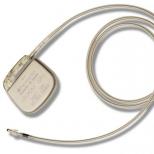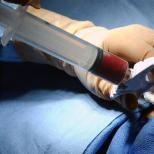Cardiogram of the heart and its meaning
A cardiogram is a procedure that registers various cardiac pathologies. Each person, feeling unwell, can make such a diagnosis, even at home. Almost every ambulance has this machine, so the cardiogram of the heart is often done at home. This method allows you to identify at an early stage, and deliver such a patient to the hospital department as soon as possible.
If we approach the decoding of the indicators of this study in a generalized way and from the position of a beginner, then it is quite possible to independently understand what the cardiogram shows. The more often the teeth are located on the cardiograph tape, the faster the myocardium contracts. If heartbeats are rare, then zigzags on the cardiogram will be shown much less frequently. In fact, such indicators reflect the nerve impulse of the heart.
Using the diagnostic method - a cardiogram of the heart, it is possible to timely identify cardiac pathologies in people with diabetes, since they often develop such abnormalities of a cardiovascular nature. This is necessary to prevent the development of such ailments and their complications in the form of a heart attack, stroke, hypertensive crisis.
What is needed to make a diagnosis by electrocardiogram:
- Time intervals between heartbeats.
- Age data of the patient.
- Peak height.
- The presence of aggravating moments or their absence.
A normal ECG (electrocardiogram) is also necessary for pregnant women to carry a fetus. For all ladies in position, this study is regularly carried out without fail. If a woman, while waiting for a baby, has a bad cardiogram, then this technique is repeated, with daily monitoring.
It should be borne in mind that this period is characterized by a displacement of all internal organs in the female body, and this affects the activity of the heart and is reflected in the electrocardiogram readings. It is necessary to decipher these indicators taking into account changes in pregnant women. In order for the ECG result to be accurate, it is necessary to familiarize yourself with the rules for preparing for this procedure.
Preparing for an ECG
Before making a cardiogram, the doctor will tell the patient about all the moments of preparation for the study.
What can cause incorrect ECG readings:
- the use of any alcohol-containing drinks, as well as energy cocktails;
- smoking 3-4 hours before the procedure;
- excessive food intake 3-4 hours before the study. It is better to do a cardiogram on an empty stomach;
- strong physical activity the day before;
- emotional overstrain;
- the use of medications that affect the activity of the heart;
- coffee drunk 2-3 hours before the ECG.

Many people forget that the decoding of the cardiogram can erroneously show the presence of pathologies, due to the experiences experienced by the person the day before or if the patient was late for the ECG, he ran to the office.
Before conducting an ECG, you need to sit quietly in the corridor, relaxing and not thinking about anything, for about 10-15 minutes.
Carrying out a cardiogram will not take much time. A person entering the office should undress to the waist and lie down on the couch. Sometimes the doctor asks to remove all clothing down to underwear before the examination, which is due to a diagnosis that is suspected in this patient. Next, the physician applies a special agent in the form of a gel to certain areas of the body, which serve as attachment points for the wires coming from the cardiograph.
With the help of special electrodes located on the right areas, the device picks up even the slightest heart impulses, which are reflected on the cardiograph tape in the form of a straight line. The duration of the procedure varies in the range of several minutes.
How to decipher a cardiogram?
The recorder reflects on paper the heart impulses passing through all departments of this organ for a certain time period. In addition to zigzags, some marks are visible on the tape, which contribute to a more accurate decoding of the result. Reading a cardiogram is quite difficult. An ordinary person who does not have a medical education must first study some of the nuances before deciphering.
Important values:
- R value.
- Interval P-Q/
- QRS complex.
- S-T interval.

These indicators are considered the main ones in the results of the ECG. Any cardiographer, reading the cardiogram tape, evaluates the situation by these values.
- P value. An electrical impulse passing through the sinus node sends a signal to the right atrium. At the moment, the cardiograph reads changes in the form of the upper point of excitation of the right atrium. Then, according to the conduction system, called the Bachmann bundle, the signal passes to the left atrium. Peak activity occurs during the period when the right atrium is maximally excited. On paper, these processes are reflected in the form of a sum of peak values of an excitatory nature, passing in two atria, in the left and right, are marked as a peak P. Simply put, P is an excited sinus rhythm that goes along the conduction paths, from the right atrium to the left;
- P-Q interval. At the moment of excitation of the atria, the impulse, which is already outside the sinus node, goes along the lower part of the Bachmann bundle and is sent to the atrioventricular junction, which is also called an anrioventricular junction. In this place, there is a delay in the impulse for natural reasons, which is reflected on the cardiograph tape as a straight line, otherwise called isoelectric. In order to correctly decipher such indications, one should take into account the time during which the impulse overcomes this connection and other departments. The measurement is carried out in numbers;
- QRS complex. The bundle of His and the Purkinje fibers are the pathways of the cardiac system, along them the impulse goes on its way to the ventricles. All such path on the recorder paper is reflected as a QRS complex. The excitation of the heart ventricles always occurs in a certain sequence, and the impulse overcomes this interval in a certain time, which is also very important. First, excitation occurs in the septum between the ventricles, which usually takes about 0.03 seconds. On the tape, such a process is reflected as a Q wave running slightly below the main line. Then, for 0.05 seconds, this impulse travels through the top of the heart and neighboring regions, which is reflected in the diagram as a high R wave. After that, the excitation goes to the base of the organ, which is recorded by the cardiograph as a falling S wave. All this way takes approximately 0.02 seconds. Total, the time taking the entire path of the ventricular QRS complex is 10 seconds;
- S-T interval. The moment of extinction of the electrical impulse is called the moment of decline, this process occurs due to the impossibility of prolonged excitation of myocardial cells. During this stage, the recovery process is fixed, preceding the original state, which was before the excitation. Like others, this moment is reflected by the cardiograph. The entire period of excitation and transition to extinction is shown on the tape as the value of S-T $
Each cardiac department on the cardiogram also has its own designations. The doctor, starting to decipher the points, sees failures and disturbances in all areas of the heart.

Designations:
- I - anterior heart wall.
- II - general display of I and III.
- III - posterior heart wall.
- aVR - lateral cardiac wall on the right.
- aVL - anterior lateral cardiac wall on the left.
- aVF – inferior-posterior cardiac wall.
- V1 and V2 are the right cardiac ventricle.
- V3 is the septum between the ventricles.
- V4 is the upper part of the heart.
- V5 - anterior lateral cardiac wall of the left ventricle.
- v6 - wall of the left ventricle from the side.
Each person, having studied the above information, will already have an idea of \u200b\u200bhow to decipher the cardiogram of the heart. It is important to know the special terms used by doctors in describing the cardiograph tape.
ECG description definitions:
- The heart rate in a healthy person is between 60 and 90 heart beats per minute. Minor deviations from normal readings, without the concomitance of other unpleasant symptoms, can only mean that the person is worried, and he does not have heart disease. Doctors write this definition as heart rate;
- non-sinus rhythm in decoding means that cardiac activity is impaired, and sinus rhythm indicates the correct functioning of the heart;
- EOS (electrical axis of the heart). This characteristic shows the place in the sternum where, in fact, the heart is located. An example of a transcript, in which violations are visible, is presented in the form - the heart is located with a deviation to the left or right, horizontally, vertically. Often, doctors conclude by writing that this organ is located normally. If the patient is diagnosed with hypertension, then the cardiograph tape will show the deviation of the heart to the left or its position will be horizontal. Chronic lung diseases are displayed on the cardiogram as a deviation of the heart to the right. In an asthenic person, this organ is in a vertical position, and in a patient of a dense physique, the tape recorder will show that the heart is in a horizontal position.
- Sinus arrhythmia - is considered not associated with respiratory pathology, but is one of the signs of the disease.
Example
By studying all the parameters of the cardiogram, the doctor makes a conclusion about the work of the heart. In order to understand what a cardiograph tape looks like in a healthy person, you need to pay attention to all the parameters of this study.
Normal adult ECG:
- Sinus rhythm of the heart.
- P wave - 0.1.
- Heart rate - 60 heart beats in 1 minute.
- QRS is considered acceptable with parameters from 0.06 to 0.1.
- QT - from 0.4 and less.
- RR - 0.6.
If these characteristics deviate slightly from normal values, the question of the presence of pathologies is not considered. In the case when the deviations are significant, a number of diagnostic measures are needed to help clarify the clinical picture.
Children also need to conduct such a study as an ECG. However, the indicators of the cardiogram of an adult and a child are very different. In order to decipher the cardiograph tape with indicators of the child's cardiac activity, it is necessary to take into account the normal values \u200b\u200bof the results of this examination in children.
Normal ECG in a child:
- The rhythm of the heart is sinus.
- Prong P - within 0.1 and less.
- Heart rate in children of different ages is different. In babies under 3 years old, this indicator is in the region of 100 or less heart beats in 1 minute. In children about 5 years old - no more than 90 heartbeats. Adolescents have 90 strokes or less.
- QRS in all children under 14 years of age should be 0.16. If a teenager is 14-17 years old, then PQ is shown within 0.18, and older people, who are over 17 years old, have a normal PQ-0.2 value.
In the case when the ECG of the child showed a violation of the functioning of the heart, an urgent consultation of a cardiologist is necessary. What to do next, only a specialist will tell. It is important to consider that heart pathologies in children can develop from birth and during the development of the fetus in the womb. To exclude the occurrence of such ailments and to detect them in time, a woman, during the bearing of a child, undergoes an ECG. The result shown on the recorder tape can reveal the presence of heart pathologies, both in the fetus and in the mother.
Many are concerned about questions about how a cardiogram is done, when and how many times during the year. There is no single answer. Some patients are assigned a cardiogram with additional studies, since ECG readings alone are not enough to make an accurate diagnosis.
A cardiogram is prescribed in many situations. Sometimes the indication for this study is excess weight, and sometimes quite serious symptoms, indicating malfunctions of the heart. As for the frequency with which an ECG should be done, then once a year this procedure is necessary for all people over the age of 40 years. To take a referral for an electrocardiogram, you do not need to go specifically to a cardiologist, a doctor of any specialization can give it.
The passage of a cardiogram of the heart is necessary for every person experiencing ailments, indicating a violation of the activity of this organ. This procedure is simple, so do not neglect it.
 How to cure hypertension permanently?!
How to cure hypertension permanently?!
In Russia, from 5 to 10 million calls to the ambulance for increased pressure occur annually. But the Russian cardiac surgeon Irina Chazova claims that 67% of hypertensive patients do not even suspect that they are sick!
How can you protect yourself and overcome the disease? One of the many cured patients, Oleg Tabakov, told in his interview how to forget about hypertension forever ...






